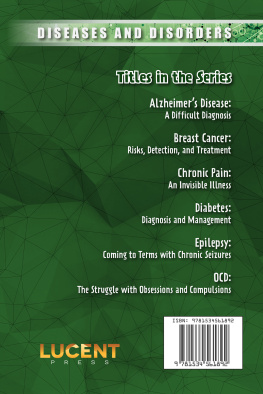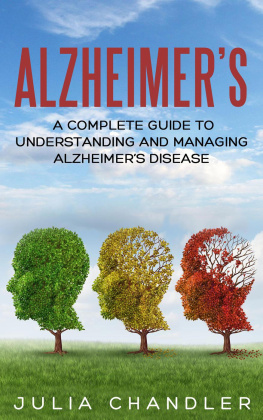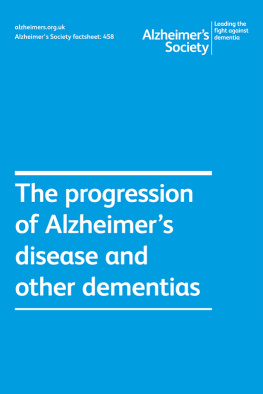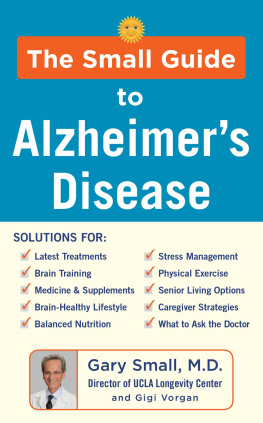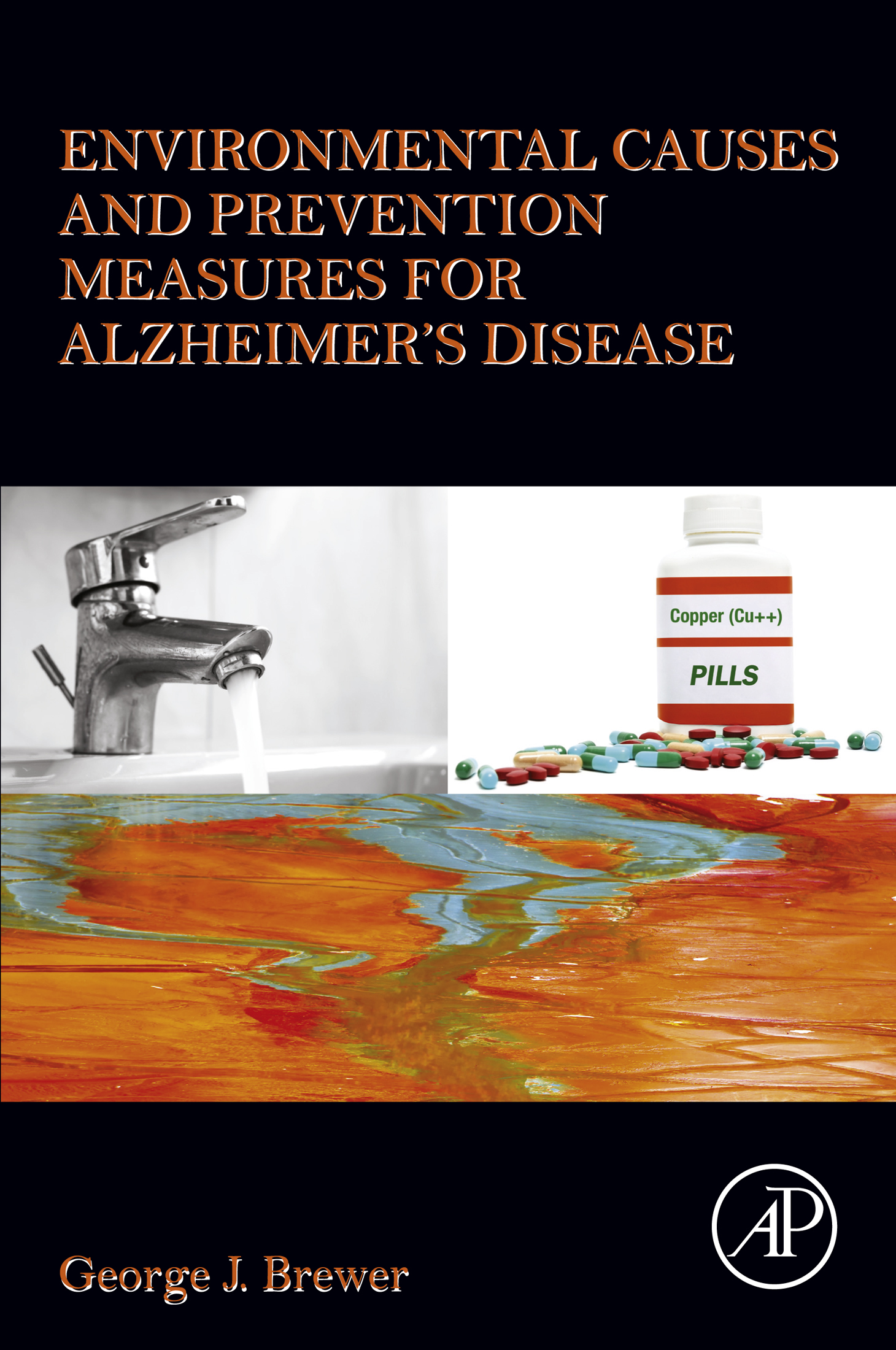Table of Contents
List of Figures
- Figures in Chapter One
- Figures in Chapter Two
- Figures in Chapter Three
List of Tables
- Tables in Chapter Two
- Tables in Chapter Five
- Tables in Chapter Eight
- Tables in Chapter Ten
- Tables in Chapter Thirteen
Landmarks
Environmental Causes and Prevention Measures for Alzheimers Disease
Table of Contents
Copyright
Academic Press is an imprint of Elsevier
125 London Wall, London EC2Y 5AS, United Kingdom
525 B Street, Suite 1800, San Diego, CA 92101-4495, United States
50 Hampshire Street, 5th Floor, Cambridge, MA 02139, United States
The Boulevard, Langford Lane, Kidlington, Oxford OX5 1GB, United Kingdom
Copyright 2018 Elsevier Inc. All rights reserved.
No part of this publication may be reproduced or transmitted in any form or by any means, electronic or mechanical, including photocopying, recording, or any information storage and retrieval system, without permission in writing from the publisher. Details on how to seek permission, further information about the Publishers permissions policies and our arrangements with organizations such as the Copyright Clearance Center and the Copyright Licensing Agency, can be found at our website: www.elsevier.com/permissions.
This book and the individual contributions contained in it are protected under copyright by the Publisher (other than as may be noted herein).
Notices
Knowledge and best practice in this field are constantly changing. As new research and experience broaden our understanding, changes in research methods, professional practices, or medical treatment may become necessary.
Practitioners and researchers may always rely on their own experience and knowledge in evaluating and using any information, methods, compounds, or experiments described herein. In using such information or methods they should be mindful of their own safety and the safety of others, including parties for whom they have a professional responsibility.
To the fullest extent of the law, neither the Publisher nor the authors, contributors, or editors, assume any liability for any injury and/or damage to persons or property as a matter of products liability, negligence or otherwise, or from any use or operation of any methods, products, instructions, or ideas contained in the material herein.
Library of Congress Cataloging-in-Publication Data
A catalog record for this book is available from the Library of Congress
British Library Cataloguing-in-Publication Data
A catalogue record for this book is available from the British Library
ISBN: 978-0-12-811162-8
For information on all Academic Press publications visit our website at https://www.elsevier.com/books-and-journals

Publisher : Nikki Levy
Acquisition Editor : Natalie Farra
Editorial Project Manager : Kathy Padilla
Production Project Manager : Stalin Viswanathan
Designer : Miles Hitchen
Typeset by TNQ Books and Journals
Dedication
I dedicate this book to my wonderful wife, Lucia (Feitler) Brewer. She has devoted herself to me through good times and bad times, always loyal, always supportive, and always ready to laugh at my sometimes silly jokes. She started out as a research assistant in my laboratory, and the rest is history. She always has good advice and I received plenty of it in writing this book. We just celebrated our 47th wedding anniversary and I am ready for 47 more. I love her and love living with her, and I appreciate all she does for me .
Foreword
In less than 40 years, Alzheimers disease (AD) has transformed from unknown to the most dreaded ailment existing today. Nearly half of those over 85 years of age are affected. Is the increase from awareness, incidence, or both? We do not know for sure, but Dr. Brewer presents evidence that increased AD may result from ingestion of drinking water containing divalent copper-2 rather than the monovalent copper-1 found in food. In contrast to copper-1, which is rapidly stored in the liver, copper-2 is also accumulated in the brain.
Accumulated copper may play a critical role in the increased AD seen in developed societies or the several-fold differential in prevalence seen between ethnic groups. Dr. Brewer makes several persuasive arguments, among them that coppers strong interaction with amyloid protein precursor and amyloid reduces redox activity. Dr. Brewer further provides critical public health implications of copper dysregulation and the need for further study. His synthesis offers hope to AD research for prevention and treatment.
GeorgePerry, PhD , College of Sciences, The University of Texas at San Antonio, San Antonio, Texas
Acknowledgments
First I would like to acknowledge the invaluable help of my chief word processor, Ann Arnold. Ann has the patience of a saint, and she needed it to work through and type my long hand scribbling as I wrote this book. She also helped keep this relatively complex project organized. Thanks also to my loyal former secretary, Julia Sitterly, who still helps me with some word processing, and keeps and sends out as necessary personal office items such as my CV, my picture, etc. I also appreciate the assistance of my loyal and excellent former chief technician, Robert Dick, who still does some moonlight work in our laboratory, formats data, trouble shoots my computer, and helps me find references, including many for this book.
I also would like to thank the excellent staff at Elsevier, in particular Natalie Farra, and Kathy Padilla, both of whom were extremely helpful in the publishing process.
Chapter One
Introduction
Abstract
Chapter 1 is an introduction to the book. A brief description of Alzheimers disease (AD) is given, although a much more detailed description will be given in Chapter 2. It is pointed out that AD is a disease of cognition loss in people aged 60 and over, and a brief description of the brain pathology is given. Then the chapter briefly discusses what is in the rest of the book. A highlight is in Chapter 3, where surprising and important facts about AD are givennamely it is in epidemic prevalence in developed countries but rare in undeveloped countries, and the epidemic in developed countries has occurred in the last 100 years. It was rare before 1900. These facts cry out, Something in the environment in developed countries is causing the epidemic. Then there are two chapters searching for the environmental agent or agents, and then a chapter describing copper, particularly divalent copper or copper-2, as a major culprit. Then there are several chapters giving copper background and detailing how copper and, specifically, copper-2 are causative of AD. At this point in Chapter 1, the fascinating story of how chance and careful investigation led to the experimental demonstration that copper-2 in drinking water was causative of AD in an animal model. Chapter 1 then returns to the book overview. Chapter 8 puts together an overwhelming web of evidence that copper-2 is a major causal factor for the AD epidemic in developed countries that has emerged in the last 100 years. Chapter 9 shows how an increased body load of copper in general (irrespective of valence), occurring because of dietary changes in developed countries, is also contributing to the epidemic. Chapter 10 shows how nicely the copper hypothesis fits with known risk factors and current theories of AD causation. Chapter 11 is very important because it describes how people can almost completely avoid this disastrous disease by two easy steps that almost completely eliminate ingestion of copper-2. Dietary changes that reduce copper absorption are also discussed. The final chapter, Chapter 12, discusses how the federal government has failed to set proper standards for drinking water copper content and failed to assure safety of multimineral supplement pills by eliminating copper-2 in them.



